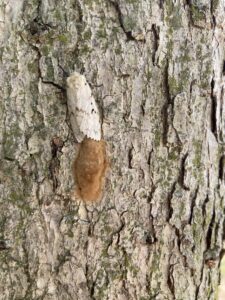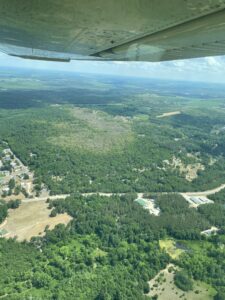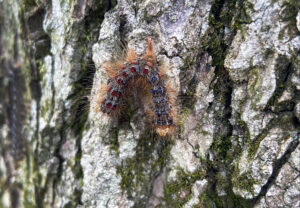
A female spongy moth lays a tan-colored egg mass on an oak tree at the Kettle Moraine State Forest – Southern Unit on July 25. Photo Credit: Bill McNee, Wisconsin DNR
By Bill McNee, DNR Forest Health Specialist, Oshkosh; bill.mcnee@wisconsin.gov or 920-360-0942
In many areas across Wisconsin, conditions were right for the worst outbreak of spongy moth caterpillars (Lymantria dispar) in more than a decade.
The caterpillars of this invasive insect — formerly known as gypsy moth — prefer to feed on oak, birch, crabapple, aspen and willow leaves, but will also feed on many other tree and shrub species. As of early August, caterpillars have pupated, but adult moths remain present.

A patch of heavy spongy moth defoliation observed in Columbia County on July 6. Photo Credit: Mike Hillstrom, Wisconsin DNR
Defoliation
In aerial surveys performed this summer, about 373,000 acres of spongy moth defoliation were observed. This total exceeds the previous record of 347,000 acres of spongy moth defoliation, set in 2010. Most of this defoliation was observed in northern Wisconsin (primarily Ashland, Bayfield and Marinette counties). Bayfield County had the most defoliation, with approximately 145,000 acres observed. Marinette County had the second-highest amount at nearly 95,000 acres.
The most affected tree species were oak in the south, and aspen and oak in northern counties. Other defoliating insects are also active on oak and other tree species this summer, increasing the total area of forest defoliation. All numbers listed are preliminary.
The last two summers have shown that spongy moth can do very well in the colder climate of far northern Wisconsin when weather conditions are favorable.

A preliminary map of recorded spongy moth defoliation. Note: Red areas are enhanced to better show small areas of defoliation. Graphic Credit: Mike Hillstrom, Wisconsin DNR
Disease
The incidence of diseases that attack spongy moth and other caterpillars was predicted to be below average due to the dry weather this spring and summer. In general, that forecast held true. With a few exceptions, the only observations of moderate caterpillar mortality came from the southeast counties. There, about half of caterpillars were observed to be dead or low vigor, and about half of the caterpillars appeared healthy or had already pupated. The presence of many dead caterpillars is a sign that the outbreak is ending or in decline. Unreported mortality may be present elsewhere.
One additional sign that an outbreak is probably past its peak at a site is the presence of many new egg masses that are smaller than normal. The female moth that produced a small egg mass was likely infected with a sublethal dose of the nucleopolyhedrosis virus (NPV) or may have been undernourished as a caterpillar.
Tree Refoliation
Heavy defoliation was observed on tens of thousands of acres in southern Wisconsin in early July. Since then, “refoliation” (when a tree produces a second set of leaves) has been occurring on hardwood trees that were heavily defoliated by the leaf-eating caterpillars.
Monitoring in southeast Wisconsin in late July showed that most trees were refoliating well, with some trees exhibiting dieback or mortality due to the combined stresses of drought and defoliation. Refoliation is likely occurring in northern counties as of early August. Refoliation is a good sign that a tree retained enough vigor to produce a new set of leaves.

A spongy moth caterpillar killed by a virus hangs on a tree at the Kettle Moraine State Forest – Southern Unit on June 27. Photo Credit: Bill McNee, Wisconsin DNR
Heavily defoliated trees sometimes linger for several years before finally dying, and this should be taken into consideration when timing a timber harvest.
Recent rainfall across much of Wisconsin will help to reduce tree stress due to summer drought and heavy caterpillar defoliation. Watering high-value trees weekly when there is no heavy rainfall will continue to help trees recover from drought and defoliation.
Early 2024 Forecast
At present, it appears that the outbreak did not collapse in either southern or northern Wisconsin and is expected to continue in 2024 at an unknown intensity. Several sites sampled at the Kettle Moraine State Forest – Southern Unit showed a declining population with enough new egg masses to cause nuisance and defoliation problems next year. Preliminary evaluations have not yet been conducted elsewhere.
However, several property owners have reported many adult moths in areas that were not defoliated, suggesting a spread of the defoliation next year. Egg mass surveys can be performed by property owners this fall and winter to predict the intensity of next year’s defoliation and determine which management actions would be suitable. Newly produced egg masses will not hatch until next spring.

An oak branch at Kettle Moraine State Forest – Southern Unit shows new oak leaves (refoliation) produced among the veins of the original leaves that were eaten by spongy moth caterpillars in June. Photo Credit: Bill McNee, Wisconsin DNR
In Wisconsin, high populations typically last at a location for 1-3 years before declining to a low level. Outbreaks usually occur about every five years on dry, sandy sites and about every 10 years on other sites with suitable forest cover.
Property owners are encouraged to examine their trees and take action during the year. Specifically:
- Visit the Wisconsin spongy moth website for management information.
- Water yard trees weekly during dry periods to help reduce tree stress and aid a tree’s recovery from heavy defoliation by the caterpillars.
- Wait to cut down any trees that are defoliated. Healthy hardwood trees usually produce a new set of leaves in a few weeks’ time.
- Forest management may need to be postponed in areas that are defoliated. Trees will be stressed from heavy defoliation and will often be unable to handle the additional stress of forest thinning.
- Oil the newly produced egg masses with a horticultural oil or scrape the masses into a bucket of soapy water and let them soak for a few days before discarding in the trash.
- Remove egg masses and other life stages from vehicles and outdoor belongings before moving them.
- Don’t move untreated firewood long distances and look for certified firewood that has been treated to kill pests.
- Management options for caterpillars next spring include sticky barriers, using burlap collection bands, drowning or destroying caterpillars, and applying insecticide to protect trees and reduce nuisance caterpillar numbers.
- Insecticide treatments can be a suitable option for high-value host trees but are not practical for woodlots.
- Avoid touching the hairy caterpillars, adult moths and egg masses. The hairs often cause a skin rash, welts or other irritation. Rubbing alcohol can help to remove the hairs and chemical irritants from skin that is exposed to the hairs.
